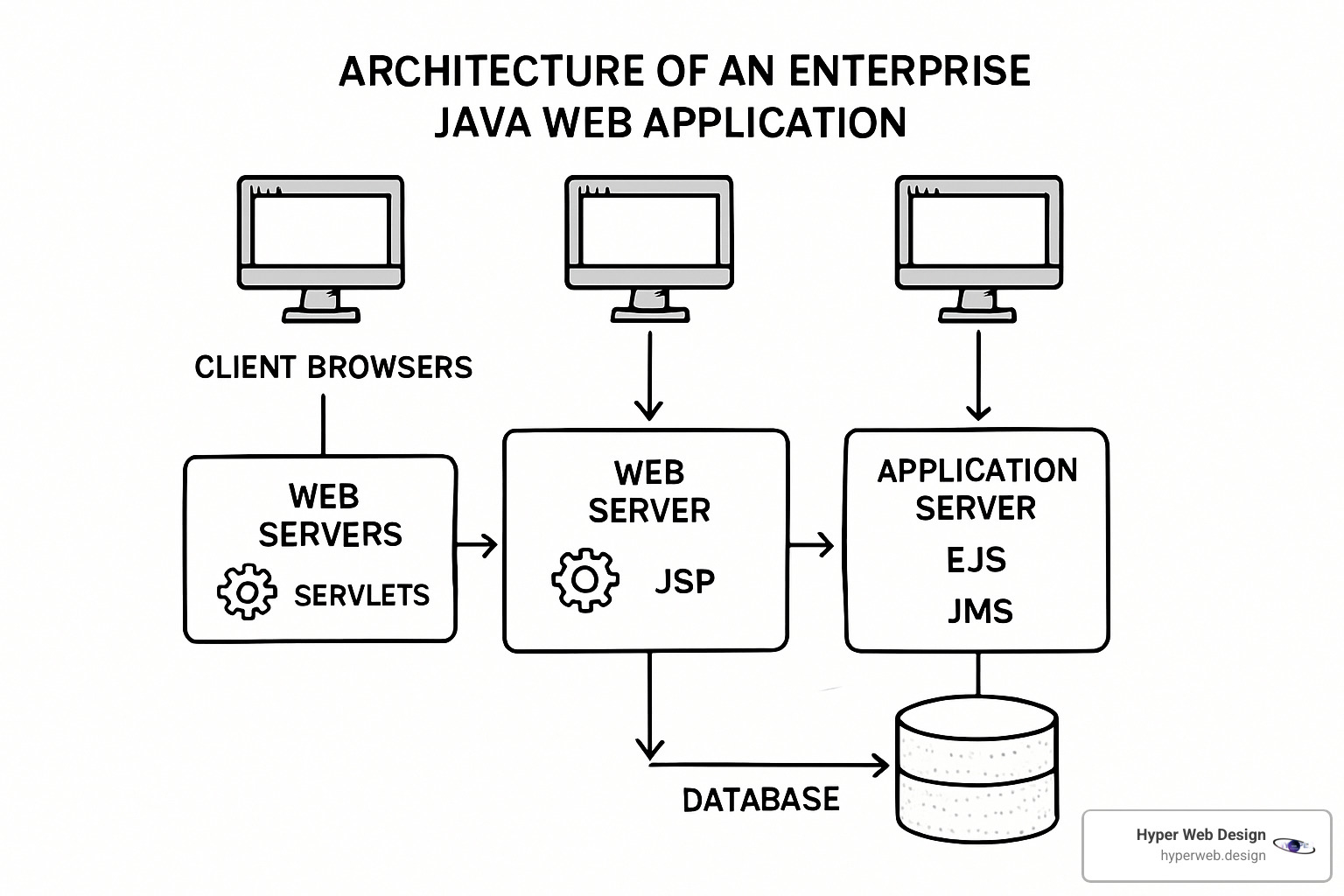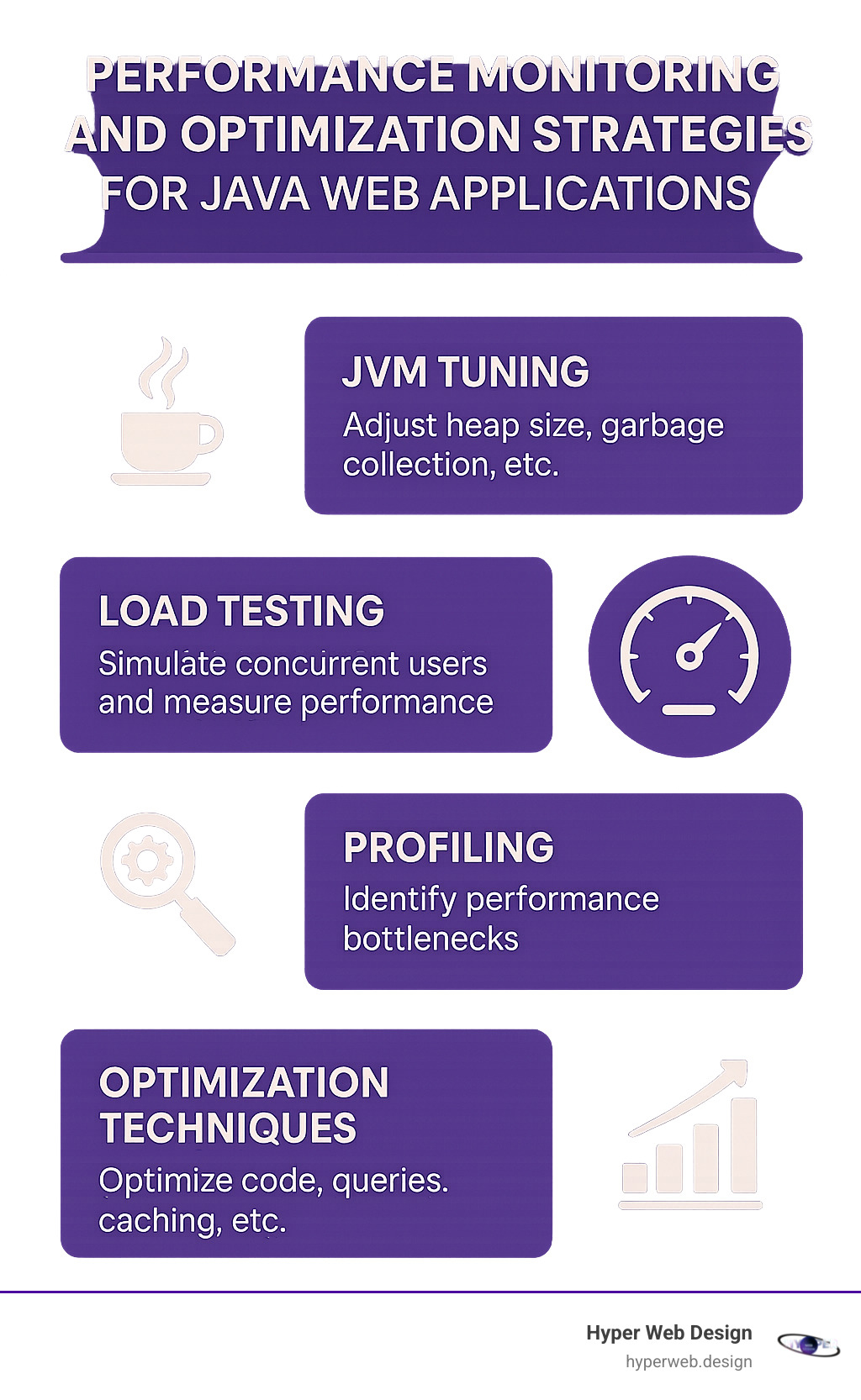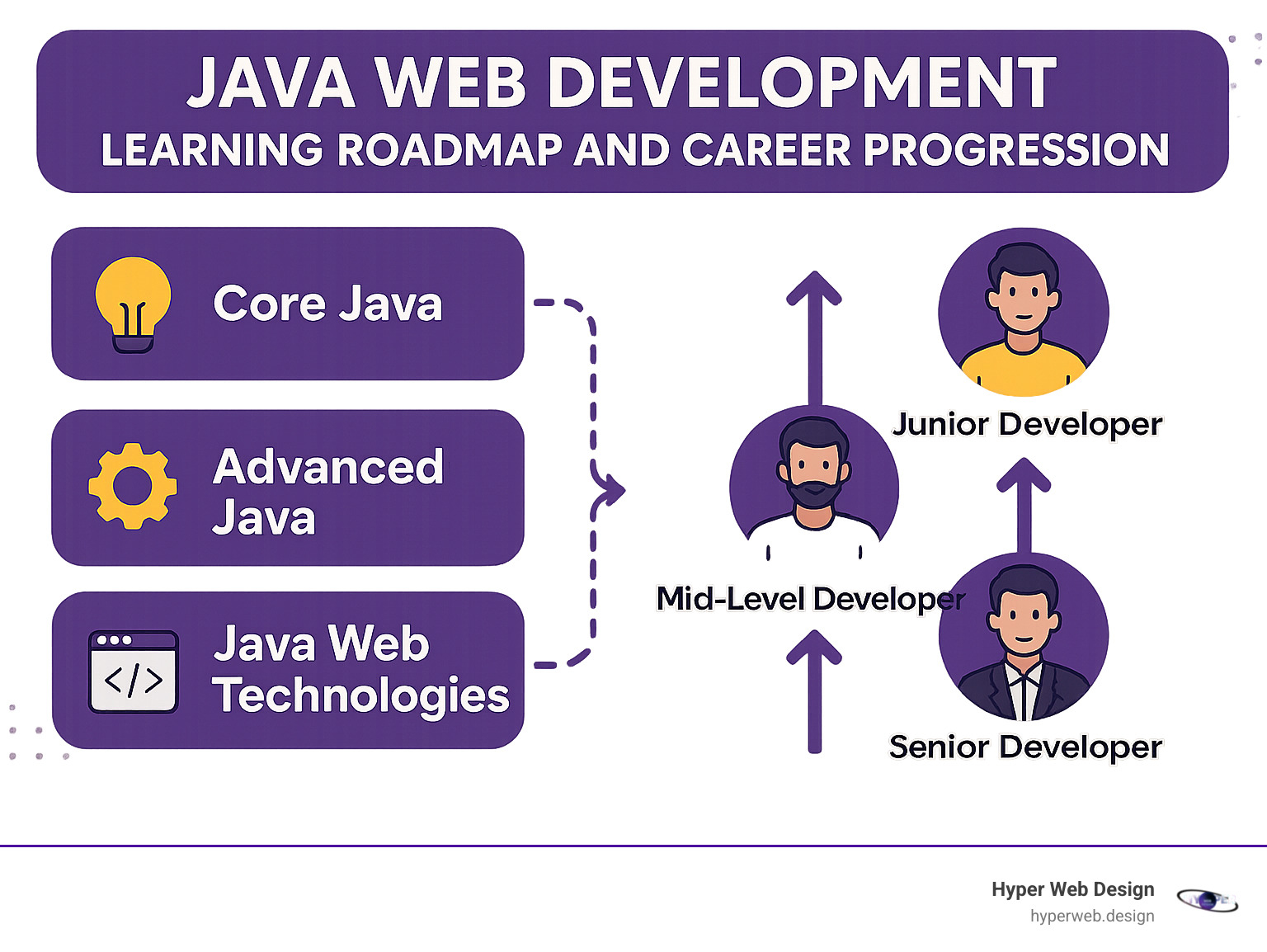Core vs Advanced Java: Foundation for Web Excellence
Understanding the distinction between Core and Advanced Java is crucial for any developer looking to build enterprise-grade web applications. Think of Core Java as learning to drive a car, while advanced java web technologies are like mastering Formula 1 racing – same basic principles, completely different level of sophistication.
Core Java covers the fundamentals: syntax, object-oriented programming principles, collections framework, basic multithreading, and exception handling. It’s designed for standalone applications and basic programming logic.
Advanced Java focuses on enterprise and web application technologies – from handling HTTP requests with Servlets to managing complex database operations with JPA, from creating rich user interfaces with JSF to building scalable messaging systems with JMS.
| Core Java | Advanced Java |
|---|---|
| Basic syntax and OOP | Enterprise frameworks (Spring, JSF) |
| Collections and data structures | Web technologies (Servlets, JSP) |
| File I/O and basic networking | Database connectivity (JDBC, JPA) |
| Simple multithreading | Advanced concurrency patterns |
| Exception handling | Enterprise messaging (JMS) |
| Standard libraries | Web services and APIs |
Why Move Beyond Core?
The transition to advanced java web technologies becomes essential when you need to solve three critical challenges that Core Java simply can’t handle effectively:
Scalability – Core Java applications might handle dozens of users, but Advanced Java provides frameworks like Spring Boot with built-in load balancing, connection pooling, and distributed caching for thousands or millions of users.
Security – While Core Java offers basic security features, web applications face sophisticated threats. Advanced Java technologies like Spring Security provide comprehensive protection with OAuth integration, CSRF protection, and secure session management.
Dynamic content creation – Core Java generates static content, but modern web applications need personalized experiences, form processing, file uploads, and real-time database integration. Technologies like JSP and JSF make this possible while maintaining clean separation between presentation and business logic.
Developers using advanced frameworks report 4-16× productivity boosts compared to building everything from scratch with Core Java.
Pillars of Advanced Java Web Technologies
Building enterprise-grade web applications requires solid foundational technologies that work together seamlessly. The foundation of advanced java web technologies rests on several core technologies, each solving specific challenges for applications serving thousands of users.
Servlets handle the fundamental request-response cycle that makes web communication possible. They receive requests, process them according to your business rules, and serve up exactly what each customer needs.
JavaServer Pages (JSP) and JavaServer Pages Standard Tag Library (JSTL) transform raw data into dynamic web pages. JSP acts as a smart template engine that adapts content based on user interactions, while JSTL provides clean, reusable tags that eliminate messy code blocks.
JavaServer Faces (JSF) offers a component-based approach for rich user interfaces. JSF manages the complex component tree, handles user interactions, and maintains state across multiple page requests.
Data management relies on JDBC for fundamental database connectivity and Java Persistence API (JPA) for sophisticated object-relational mapping that eliminates boilerplate code.
Enterprise JavaBeans (EJB) manage business logic and transaction processing, while Java Message Service (JMS) enables reliable asynchronous communication between different systems.
For developers who want to dive deeper, Oracle provides comprehensive documentation at their technical resources section.
How Servlets Fit into Advanced Java Web Technologies
Servlets are the backstage crew working behind every Java web application. When someone clicks a button on your website, the web server receives that HTTP request and checks if the appropriate servlet is ready. The server calls the service() method, which typically hands off work to specific methods like doGet() or doPost().
Servlet containers like Apache Tomcat handle all the complex networking, threading, and lifecycle management automatically. You focus on business logic while the container manages connections, thread safety, and resource cleanup.
Servlets excel at handling the full spectrum of web interactions – from simple contact forms to complex file uploads, real-time AJAX calls, user authentication, and enterprise component integration. The stateless design makes servlets naturally scalable for distributed environments.
JSP & JSTL in Advanced Java Web Technologies
JavaServer Pages solved web development’s persistent challenge: creating dynamic content without mixing business logic with HTML markup. JSP acts as an intelligent template engine that keeps your presentation layer clean while providing full Java power.
Combining JSP with JavaServer Pages Standard Tag Library (JSTL) provides clean, XML-like tags for common operations. Instead of embedding raw Java code, JSTL offers readable templates using tags like <c:forEach> with Expression Language (EL) for accessing data from different scopes.
JSP’s include directive system allows modular site navigation – update navigation site-wide by changing a single file. The compilation process gives you performance benefits of compiled Java code with template-based markup convenience.
Data Persistence with JDBC & JPA
JDBC (Java Database Connectivity) provides foundational database communication with flexibility and control. You can write optimized SQL queries and manage transactions precisely, though this requires substantial boilerplate code.
Java Persistence API (JPA) addresses these challenges through object-relational mapping that bridges Java objects and database tables. Instead of writing SQL statements and manually converting database rows, JPA handles database interaction behind the scenes.
JPA provides automatic dirty checking, lazy loading, intelligent caching, and query optimization. Spring Data JPA takes convenience further – create database operations by simply defining method signatures, and Spring Data generates implementation automatically.
Messaging & Integration
Java Message Service (JMS) provides robust messaging foundations for advanced java web technologies. JMS supports point-to-point messaging (each message processed by exactly one consumer) and publish-subscribe messaging (multiple consumers receive the same message).
JMS reliability features include message persistence, transaction support, and guaranteed delivery options. Asynchronous processing dramatically improves responsiveness and scalability by allowing systems to send messages and continue processing immediately rather than waiting for responses.
Cutting-Edge Frameworks & Tools for Enterprise Scale
The world of advanced java web technologies has transformed dramatically. What used to require weeks of configuration can now be accomplished in minutes.
Spring Boot eliminated the complexity of enterprise Java development. Instead of dozens of XML configuration files, Spring Boot provides production-ready applications with minimal configuration. Embedded servers eliminate deployment container worries during development, and comprehensive monitoring comes built-in.
Hibernate remains the heavyweight champion of object-relational mapping with sophisticated caching mechanisms, lazy loading strategies, and query optimization for high-performance database applications.
Cloud-native runtimes like Quarkus and Micronaut were built for containers and serverless computing. Traditional Java applications taking minutes to start don’t work in environments requiring instant scaling.
Vaadin lets Java-focused teams build modern web applications entirely in Java, perfect for leveraging existing Java expertise without mastering multiple programming languages.
Build automation tools Maven and Gradle evolved from dependency managers into comprehensive development orchestration platforms, integrating seamlessly with IDEs and CI/CD pipelines.
For enterprise-level web solutions, check out the open-source project JAX-WS for web services development.
Spring Ecosystem Highlights
The Spring ecosystem has become enterprise Java development’s backbone. Over 50% of Java developers rely on Spring, and its Inversion of Control (IoC) container handles object creation, dependency injection, and lifecycle management automatically.
Spring MVC makes building web applications natural. Annotation-based configuration means creating RESTful APIs with just a few annotations. Complex request routing? Spring MVC handles it while staying out of your way.
Spring Security provides comprehensive authentication and authorization, CSRF attack protection, and integration with OAuth and SAML. Its declarative approach secures applications with annotations rather than scattered security code.
Spring Data makes database access effortless. Define interfaces with method names following Spring conventions, and the framework generates implementation code automatically for relational databases, NoSQL stores, or cloud-based storage services.
Cloud-Native Runtimes
Traditional Java applications taking 30-60 seconds to boot can’t effectively scale with demand or leverage serverless computing models.
Quarkus solves this through compile-time optimization and native compilation using GraalVM. Applications start in milliseconds rather than minutes and consume dramatically less memory, translating to real cost savings in cloud environments.
Micronaut focuses on compile-time dependency injection and aspect-oriented programming. By moving framework overhead from runtime to compile-time, applications start faster and use less memory while maintaining developer productivity benefits.
These cloud-native runtimes don’t sacrifice functionality for performance. You still get comprehensive database connectivity, messaging capabilities, security features, and monitoring tools optimized for container and serverless deployment patterns.
Best Practices for Secure, Scalable, Maintainable Apps
Building rock-solid applications with advanced java web technologies requires following time-tested patterns that prevent future headaches.
The Model-View-Controller (MVC) pattern keeps things organized when complexity creeps in. By separating business logic from presentation and data access, you create applications that are easier to debug, test, and modify.
RESTful design principles provide consistent, predictable interfaces using standard HTTP methods like GET, POST, PUT, and DELETE with meaningful status codes.
Caching strategies with tools like Redis or Hazelcast dramatically reduce database load and improve response times. Smart cache invalidation ensures performance boosts without serving stale data.
Logging and monitoring with frameworks like Logback provide visibility when things go wrong. Integration with monitoring platforms helps spot problems before they impact users.
DevSecOps practices weave security throughout development with automated security testing, dependency vulnerability scanning, and secure coding practices.
Your CI/CD pipeline automates tedious tasks while ensuring consistency. Code quality checks, automated testing, and standardized deployments reduce human error and speed delivery.
For businesses implementing these practices effectively, our SEO & Marketing services ensure robust Java applications drive real business results.
Performance & Monitoring
Peak performance requires attention to multiple stack layers. JVM tuning – adjusting heap sizes, choosing garbage collection algorithms, and configuring JIT compilation – dramatically impacts application performance under load.
Load testing with tools like JMeter simulates realistic user behavior and reveals bottlenecks before production. The goal is understanding peak performance and graceful degradation when busy.
Database performance often becomes the biggest bottleneck. Connection pooling prevents constant connection establishment overhead, while proper indexing and query optimization keep response times snappy. JPA’s second-level caching dramatically reduces database load for read-heavy applications.
Observability goes beyond uptime monitoring. Distributed tracing helps understand request flow through complex architectures, while application performance monitoring provides real-time health insights.
Front-End Integration
Modern applications need seamless cooperation between Java backends and dynamic front-end interfaces. AJAX integration enables rich user experiences by updating page parts without full reloads through JSON-based APIs.
Cross-Origin Resource Sharing (CORS) configuration becomes essential when front-end and backend applications live on different domains. Spring Boot makes this straightforward with simple annotations.
WebSocket support enables real-time, bidirectional communication between clients and servers, invaluable for chat systems, dashboards, or collaborative tools requiring immediate feedback.
At Hyper Web Design, we create responsive website designs that integrate seamlessly with robust Java backend systems, ensuring optimal performance across all devices while maintaining enterprise-level security and scalability.
Frequently Asked Questions about Advanced Java Web Technologies
What is the key difference between Servlets and JSP?
Think of servlets and JSP as two different tools designed for different jobs in your advanced java web technologies toolkit. Servlets are pure Java classes that handle the behind-the-scenes work – processing form data, managing user sessions, connecting to databases, and controlling application flow. They’re like the engine of your car: powerful and essential, but not something users directly see.
When you write a servlet, you’re writing Java code that generates HTML output programmatically. This gives you complete control over every aspect of the HTTP request-response cycle, but it can get messy when you’re trying to create complex web pages with lots of HTML markup.
JSP takes the opposite approach by letting you write HTML with Java code sprinkled in. It’s like having a template where you can insert dynamic content wherever needed. JSP pages look more like traditional web pages, making them much easier for designers and front-end developers to work with.
Here’s the interesting part: JSP pages actually get compiled into servlets behind the scenes. So technically, everything ends up as a servlet anyway. The difference is in how you write and maintain your code.
The golden rule is simple: use servlets for controller logic and business processing, use JSP for displaying information to users. In a well-designed application, servlets handle the heavy lifting (like processing a shopping cart checkout), while JSP handles the presentation (like displaying the order confirmation page).
How does Spring Boot simplify enterprise Java development?
Spring Boot feels like having a smart assistant who sets up everything for you before you even ask. Traditional enterprise Java development required hours of configuration files, XML setup, and server configuration before you could write your first line of business logic. Spring Boot eliminates this friction by providing sensible defaults that work right out of the box.
The magic happens through auto-configuration, which is Spring Boot’s way of reading your mind. Add a database driver to your project, and Spring Boot automatically sets up connection pooling, transaction management, and data access components. Include web dependencies, and you get a fully configured web server ready to handle HTTP requests.
Embedded servers are another game-changer. Instead of installing and configuring separate application servers like Tomcat, Spring Boot includes the server inside your application. Your entire enterprise application becomes a simple JAR file that you can run with java -jar myapp.jar. This makes deployment, testing, and containerization incredibly straightforward.
Spring Boot starters deserve special mention for simplifying dependency management. Instead of hunting down compatible versions of dozens of libraries, you just include something like spring-boot-starter-web and get everything needed for web development in one neat package.
Production readiness comes built-in with Spring Boot Actuator. You get health checks, performance metrics, and monitoring endpoints without writing a single line of code. These features are essential for enterprise applications but would traditionally require weeks of custom development.
The framework strikes the perfect balance between convention and configuration. It works beautifully with zero configuration for standard use cases, but you can override any default when you need custom behavior.
Which database strategy works best with JPA?
Choosing the right database strategy with JPA is like planning a road trip – the best route depends on where you’re going and what you’re carrying. For most enterprise applications, we recommend starting with Spring Data JPA repositories combined with intelligent caching and connection pooling.
Connection pooling is absolutely non-negotiable. Never run JPA without a proper connection pool like HikariCP, which comes as the default in Spring Boot. Database connections are expensive to create, and connection pooling can improve your application performance by 10x or more by reusing existing connections instead of creating new ones for every request.
Lazy loading is a double-edged sword that needs careful handling. It’s tempting to make everything lazy-loaded to improve initial query performance, but this can create the dreaded N+1 query problem. For example, if you load a list of 100 customers and then access each customer’s orders, lazy loading might execute 101 separate database queries instead of one efficient join query.
The solution is strategic use of fetch joins and batch sizing. Use @BatchSize annotations to load related entities in batches, and use JPQL fetch joins for scenarios where you know you’ll need related data.
Second-level caching can provide dramatic performance improvements for read-heavy applications. Hibernate’s second-level cache works excellently with distributed cache providers like Redis, but you need to think carefully about cache invalidation strategies. There’s nothing worse than showing users stale data because your cache didn’t update properly.
Database indexing should align perfectly with your JPA queries. Use JPA’s @Index annotations to define indexes directly in your entity classes. This ensures your database schema supports your application’s query patterns efficiently and keeps your indexing strategy documented in your code.
For complex reporting or high-performance scenarios, don’t be afraid to mix JPA with native SQL queries. Use JPA for standard CRUD operations where it excels, and use native queries or stored procedures for complex analytics or bulk operations where raw SQL performance is crucial.
Conclusion
The journey through advanced java web technologies has taken us from basic concepts to enterprise-scale development. We’ve covered Servlets managing HTTP requests, Spring Boot revolutionizing application building, JPA handling complex data relationships, and cloud-native runtimes preparing for the future.
The advanced java web technologies we’ve explored aren’t just fancy additions – they’re the difference between applications that work and applications that thrive under real-world pressure. Java powers over 35% of enterprise web applications, and development teams report 4-16× productivity boosts from using advanced frameworks.
What strikes me about the modern Java ecosystem is how it keeps evolving while staying true to core principles. Cloud-native runtimes like Quarkus and Micronaut address real problems – fast startup times, low memory consumption, and container-friendly deployment. Meanwhile, Spring Boot continues simplifying complex enterprise development tasks.
The learning never stops, and that’s exciting. Every framework version, security improvement, and performance optimization represents collective wisdom from thousands of developers facing similar challenges. Staying current means leveraging proven solutions that make applications better.
These technologies are tools, not destinations. Real magic happens when you combine robust backend capabilities with thoughtful user experience design – where technical excellence meets strategic thinking to convert visitors into customers.
At Hyper Web Design, we’ve seen how advanced java web technologies transform digital experiences. Our approach combines enterprise Java’s security, scalability, and reliability with visual design and user experience optimization that drives business results. When you’re ready to build something that goes beyond working to making a difference, our custom website design and development services bring together the best of both worlds.
Whether you’re starting your enterprise Java journey or scaling existing applications, every expert was once a beginner. The technologies we’ve covered provide solid foundations, but real learning happens when building, testing, and iterating on real projects.
The path from Java beans to web dreams isn’t always smooth, but it’s rewarding. With the right knowledge, tools, and approach, you can build applications that don’t just meet technical requirements – they create experiences users love and businesses depend on.
Ready to see how advanced Java technologies can improve your digital presence? Our SEO and marketing services complement powerful backend development with strategic approaches that help applications reach the right audience and achieve real business impact.






